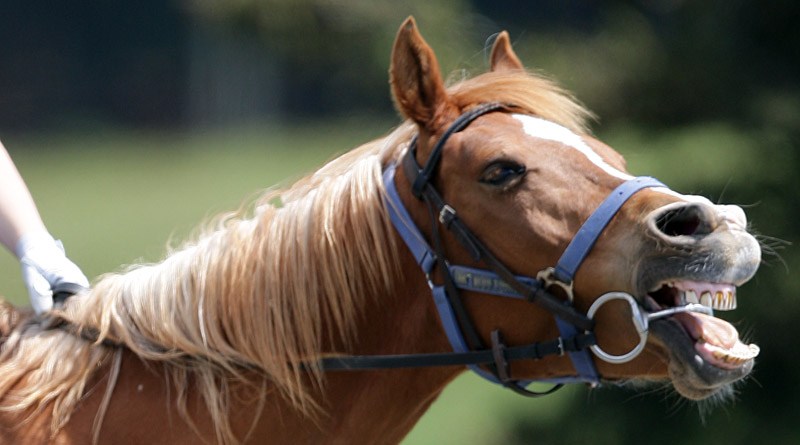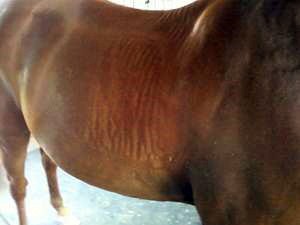
by Jochen Schleese
It’s no secret that redheads have sensitive skin. But the interesting thing is that chestnuts also have the most sensitive skin in the horse world.
As everyone knows, the skin is the largest organ of the body. (Somehow this never seemed to make sense intuitively, because to me an organ is an organ, and skin is skin, but there you have it!) That’s why creams are so readily absorbed into the blood stream and can quickly work how and where they’re supposed to. The skin is also the first line of defense against painful pressure and the skin is subject to changes that can be assessed in the evaluation of pain.
It is known that the fascia of the thoracic region (the region where the saddle is placed, also referred to as the saddle support area) is extremely sensitive to pressure and pain due to a richly innervated connective tissue web associated with the spinal cord. This is in contrast to the fascia overlying the lumbar region, which is generally more pliable and less sensitive to pain and to excessive pressure.
It is not always easy to assess the health of the skin of the thoracolumbar region. Healthy skin should be soft, contain adequate moisture and be freely movable from the underlying cutaneous muscles and be able to respond to stimuli. One can be readily fooled by horses who tend to respond less to stimuli and be convinced that those horses are not sore. However, most of those horses’ fascia is less responsive because the horses are undermuscled and underweight, old and/or suffering from chronic diseases and degenerative conditions such as kissing spine or impingement of the dorsal spinous processes. In other words, the skin has become numb due to chronic pain. I have sometimes come across clients who don’t want to let me assess their saddle fit until they have ridden for about 20 minutes – at which point their horse’s skin has become less sensitive and they can therefore ‘prove’ (and insist) that their saddle is not causing excess pressure.
Horses that suffer from chronic poor saddle fit usually have skin changes that lead to chronic skin dryness and nerve tissue atrophy with the resulting lack of response. It is unfortunate that these changes are the inevitable consequences of poor saddle fit because they make the detection of pain so much more difficult. As many horses suffer from poor saddle fit, most people have a closed mind about the possibility of pain since the detection is not straightforward. It is my hope that through education, horse owners become more cognizant of the damage that inevitably occurs from chronic pressure.

One particular client’s horse was experiencing skin ‘ripples’ as in the picture above. They are not folds but sit up from the surface as if one had literally pinched them up.
I conferred with my friend Dr. Joanna Robson, author of Recognizing the Horse in Pain … and what you can do about it.
Her thoughts were: “I suspect that these are due to a saddle sliding forward, and as it does so it is literally taking the skin with it creating folds or wrinkles — this is most visible along the topline right behind the horse’s withers for about 6 inches. If the horse is particularly sensitive and thin-skinned (as most chestnuts are), then it could also be triggering the ‘panniculus’ reflex (cutaneous trunci – the thin muscle beneath the skin that quivers when a fly lands on it), and the constant irritation also creates these wrinkles. Or as the horse sweated and then dried, it creates some wrinkles in the coat – this is more normal, but it’s the ridges at the top that bother me – again, just looks like everything slid forward taking the top layer of the skin with it and sliding it over the muscles beneath. ”
Based on what Dr. Robson wrote, this is what I suggested as a temporary alleviation of this issue until the saddle could be properly fitted. Perhaps some of you may be experiencing similar issues, and this could help you as well until a saddle fitter can refit the saddle:
- Put a lift pad (or folded tea towel) under the saddle at the withers.
- Ride with a fleece pad directly on the horses back, then the lift pad, then a thin saddle pad, then the saddle.
- Cross the billets to avoid saddle slipping forward.
Jochen Schleese is a Certified Master Saddler, Equine Ergonomist and a leader in the concept of saddle fit. He teaches his Saddlefit 4 Life philosophy worldwide. He is also the author of "Suffering in Silence" and "The Saddle-Fit Link to Physical and Psychological Trauma in Horses". Visit www.schleese.com
This article originally appeared on www.HorseTalk.co.nz and is published here with permission. Find out more about saddlery in our section on English & Western Tack.
































